Molecular Cloning of ARFGEF3 Gene
VerifiedAdded on 2022/11/29
|14
|4214
|492
AI Summary
This document discusses the molecular cloning of the ARFGEF3 gene and its role in breast cancer brain metastasis. It explores the molecular mechanism of epithelial to mesenchymal transition (EMT) and the interaction of ARFGEF3 with the PHB2/REA protein. The study also includes information on the expression of estrogen receptors and the use of siRNA to suppress the overexpression of ARFGEF3.
Contribute Materials
Your contribution can guide someone’s learning journey. Share your
documents today.

Running head: MOLECULAR CLONING OF ARFGEF3 GENE
MOLECULAR CLONING OF ARFGEF3 GENE
Name of the Student
Name of the University
Author Note
MOLECULAR CLONING OF ARFGEF3 GENE
Name of the Student
Name of the University
Author Note
Secure Best Marks with AI Grader
Need help grading? Try our AI Grader for instant feedback on your assignments.
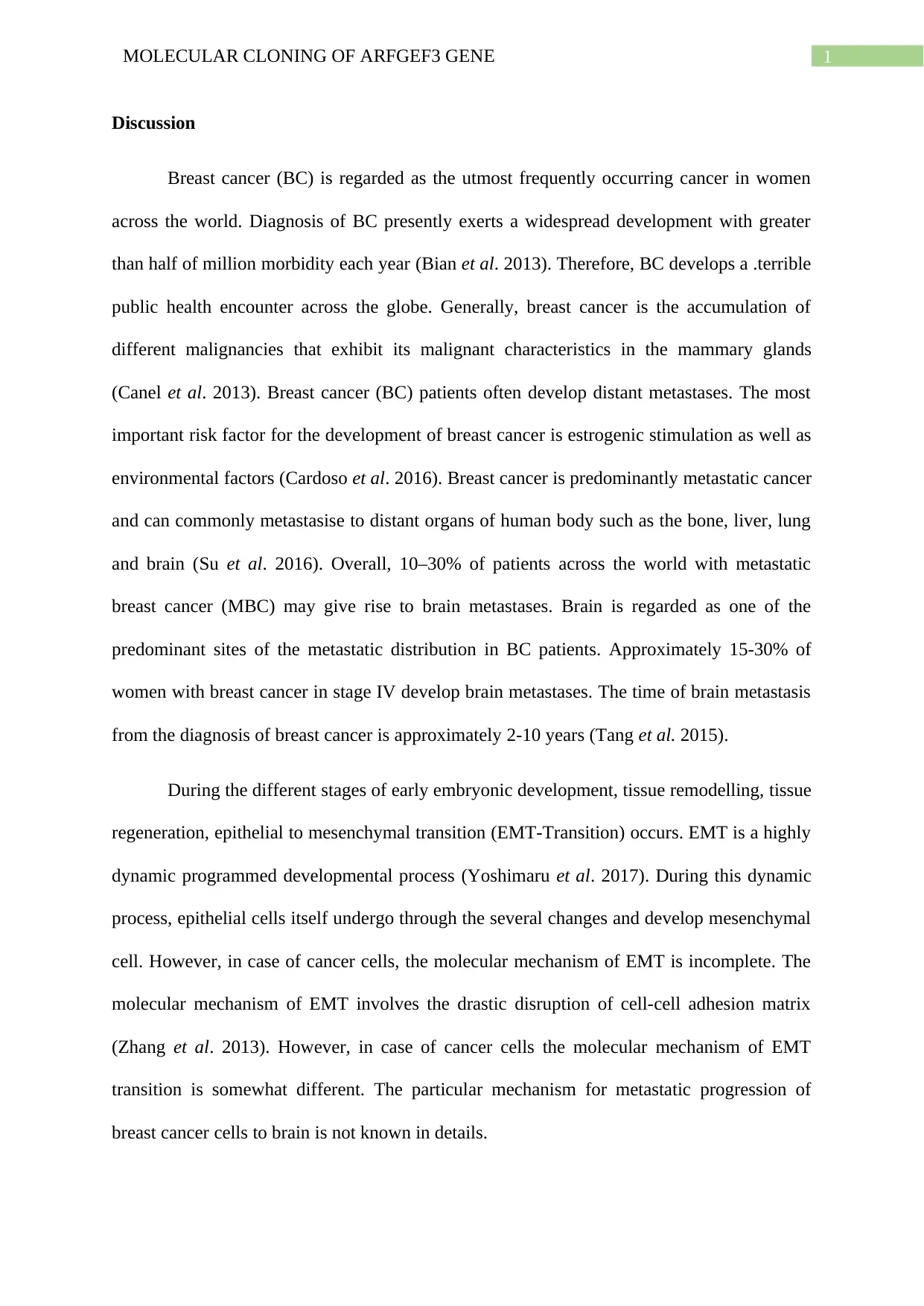
1MOLECULAR CLONING OF ARFGEF3 GENE
Discussion
Breast cancer (BC) is regarded as the utmost frequently occurring cancer in women
across the world. Diagnosis of BC presently exerts a widespread development with greater
than half of million morbidity each year (Bian et al. 2013). Therefore, BC develops a .terrible
public health encounter across the globe. Generally, breast cancer is the accumulation of
different malignancies that exhibit its malignant characteristics in the mammary glands
(Canel et al. 2013). Breast cancer (BC) patients often develop distant metastases. The most
important risk factor for the development of breast cancer is estrogenic stimulation as well as
environmental factors (Cardoso et al. 2016). Breast cancer is predominantly metastatic cancer
and can commonly metastasise to distant organs of human body such as the bone, liver, lung
and brain (Su et al. 2016). Overall, 10–30% of patients across the world with metastatic
breast cancer (MBC) may give rise to brain metastases. Brain is regarded as one of the
predominant sites of the metastatic distribution in BC patients. Approximately 15-30% of
women with breast cancer in stage IV develop brain metastases. The time of brain metastasis
from the diagnosis of breast cancer is approximately 2-10 years (Tang et al. 2015).
During the different stages of early embryonic development, tissue remodelling, tissue
regeneration, epithelial to mesenchymal transition (EMT-Transition) occurs. EMT is a highly
dynamic programmed developmental process (Yoshimaru et al. 2017). During this dynamic
process, epithelial cells itself undergo through the several changes and develop mesenchymal
cell. However, in case of cancer cells, the molecular mechanism of EMT is incomplete. The
molecular mechanism of EMT involves the drastic disruption of cell-cell adhesion matrix
(Zhang et al. 2013). However, in case of cancer cells the molecular mechanism of EMT
transition is somewhat different. The particular mechanism for metastatic progression of
breast cancer cells to brain is not known in details.
Discussion
Breast cancer (BC) is regarded as the utmost frequently occurring cancer in women
across the world. Diagnosis of BC presently exerts a widespread development with greater
than half of million morbidity each year (Bian et al. 2013). Therefore, BC develops a .terrible
public health encounter across the globe. Generally, breast cancer is the accumulation of
different malignancies that exhibit its malignant characteristics in the mammary glands
(Canel et al. 2013). Breast cancer (BC) patients often develop distant metastases. The most
important risk factor for the development of breast cancer is estrogenic stimulation as well as
environmental factors (Cardoso et al. 2016). Breast cancer is predominantly metastatic cancer
and can commonly metastasise to distant organs of human body such as the bone, liver, lung
and brain (Su et al. 2016). Overall, 10–30% of patients across the world with metastatic
breast cancer (MBC) may give rise to brain metastases. Brain is regarded as one of the
predominant sites of the metastatic distribution in BC patients. Approximately 15-30% of
women with breast cancer in stage IV develop brain metastases. The time of brain metastasis
from the diagnosis of breast cancer is approximately 2-10 years (Tang et al. 2015).
During the different stages of early embryonic development, tissue remodelling, tissue
regeneration, epithelial to mesenchymal transition (EMT-Transition) occurs. EMT is a highly
dynamic programmed developmental process (Yoshimaru et al. 2017). During this dynamic
process, epithelial cells itself undergo through the several changes and develop mesenchymal
cell. However, in case of cancer cells, the molecular mechanism of EMT is incomplete. The
molecular mechanism of EMT involves the drastic disruption of cell-cell adhesion matrix
(Zhang et al. 2013). However, in case of cancer cells the molecular mechanism of EMT
transition is somewhat different. The particular mechanism for metastatic progression of
breast cancer cells to brain is not known in details.

2MOLECULAR CLONING OF ARFGEF3 GENE
In some cases, deterioration of nervous system and brain typically occurs years even after the
removal of a breast tumour. Considering the fact that breast cancer is a hormone‐sensitive
disease. In case of breast cancer patients, estrogens exert its action through an interaction
with estrogen receptor (ER). This, in turn, enhances the proliferative and metastatic property
of breast tumor cells (Shen et al. 2015).
ADP ribosylation factors (Arfs) are basically 20‐kDa GTPases. These GTPases play
an important role in the trafficking of protein regulation. GTPases also exert its action as a
guanine‐nucleotide exchange factor in eukaryotic cells (Rostami et al. 2016). These ARFs
involve with different chaperones to assist nucleotide exchange. Generally, the Arfs found in
the mammals are catagorised into three different classes I–III (Lee et al. 2016). All of the
ARFGEFs are characterized by a central regulatory domain. The central regulatory domain is
approximately composed of 200 amino acids. This central, catalytic domain is known as the
Sec7 domain (Wang and Shang, 2013). Sec7 domain is mainly responsible for the GEF
activity. Brefeldin A‐inhibited guanine nucleotide‐exchange proteins 1 and 2 (BIG1 and
BIG2) proteins have highly conserved sec7 domains. In contrast, the BIG3 comprises of a
highly conserved Sec7 domain (Kim et al. 2015). The reason for doing the project is that
ARFGEF3 is an important GTPase factor that plays a vital role for developing breast cancer
brain metastasis (BCBM). In order to address the exact role of ARFGEF3 gene in BCBM,
molecular cloning of ARFGEF3 gene is needed to be done. Molecular cloning of that
particular ARFGEF3 has not been done before in any previous studies. However, this
experiment for the first time does the molecular cloning of the ARFGEF3 gene.
It has been further assured that in this experiment, due to the presence of BIG3
endogenous PHB2/REA was resided in the cytoplasm. Without proper E2 domain interacton,
the localization of PHB2/REA was also same. The PHB2/REA was translocated to the
nucleus without the presence of BIG3 protein. This, in turn, repressed the transcriptional
In some cases, deterioration of nervous system and brain typically occurs years even after the
removal of a breast tumour. Considering the fact that breast cancer is a hormone‐sensitive
disease. In case of breast cancer patients, estrogens exert its action through an interaction
with estrogen receptor (ER). This, in turn, enhances the proliferative and metastatic property
of breast tumor cells (Shen et al. 2015).
ADP ribosylation factors (Arfs) are basically 20‐kDa GTPases. These GTPases play
an important role in the trafficking of protein regulation. GTPases also exert its action as a
guanine‐nucleotide exchange factor in eukaryotic cells (Rostami et al. 2016). These ARFs
involve with different chaperones to assist nucleotide exchange. Generally, the Arfs found in
the mammals are catagorised into three different classes I–III (Lee et al. 2016). All of the
ARFGEFs are characterized by a central regulatory domain. The central regulatory domain is
approximately composed of 200 amino acids. This central, catalytic domain is known as the
Sec7 domain (Wang and Shang, 2013). Sec7 domain is mainly responsible for the GEF
activity. Brefeldin A‐inhibited guanine nucleotide‐exchange proteins 1 and 2 (BIG1 and
BIG2) proteins have highly conserved sec7 domains. In contrast, the BIG3 comprises of a
highly conserved Sec7 domain (Kim et al. 2015). The reason for doing the project is that
ARFGEF3 is an important GTPase factor that plays a vital role for developing breast cancer
brain metastasis (BCBM). In order to address the exact role of ARFGEF3 gene in BCBM,
molecular cloning of ARFGEF3 gene is needed to be done. Molecular cloning of that
particular ARFGEF3 has not been done before in any previous studies. However, this
experiment for the first time does the molecular cloning of the ARFGEF3 gene.
It has been further assured that in this experiment, due to the presence of BIG3
endogenous PHB2/REA was resided in the cytoplasm. Without proper E2 domain interacton,
the localization of PHB2/REA was also same. The PHB2/REA was translocated to the
nucleus without the presence of BIG3 protein. This, in turn, repressed the transcriptional

3MOLECULAR CLONING OF ARFGEF3 GENE
activity by inhibiting the function of RNA polymerase (Wagenblast et al.2015). Due to the
repression of such transcriptional activities there is no such interaction between the
PHB2/REA expression and ER alpha inactivation. In addition, these information and findings
may explain due to the repression of transcriptional activity there is no such correlation exists
between PHB2/REA expression and ERα inactivation in breast cancer cells. The BIG3
protein further interacts with the downstream protein products of ERα gene in the breast
cancer cells. In order to develop the proper understanding of the estrogen/ER signaling
pathway in breast cancer carcinogenesis the experimental data should be analyzed in more
detail (Zhou et al. 2017). Nowadays, brain metastasis (BM) is an inflexible scientific
problem. However, the prevalence of breast cancer brain metastasis (BCBM) has been
reported to range from 10–30%. There are numerous genes with increased expression
associated with brain metastasis. The overall molecular pathway involving the interaction of
BIG3 protein with PH2 protein is described below.PHB2/REA protein generally resides in
the cytoplasm. The nucleus localizing signal (NLS) present within the PHB2/REA protein
domain. In the absence of BIG3,proper activation of the NLS signal occur and this helps to
move the PHB2/REA protein from the cytoplasm to the nucleus. This protein then interacts
with the alpha subunit of the estrogen receptor (ER) (Soni et al. 2015). This interaction
causes proper regulation and expression of estrogen receptors in the breast cells. On the
contrary, in the presence of BIG3, this signaling mechanism is completely different.BIG3
binds with the PHB2/REA protein in the cytoplasm. This type of interaction consequently
prevents the NLS signal. As a result, nuclear translocation of PHB2/REA is inhibited (Lippitz
2013). This, in turn, causes constitutive and over expression of the estrogen receptor in the
breast cells. As a consequence, E2/ERα signalling pathway being consistently activated in
breast cancer cells. This whole molecular mechanism is observed during the metastatic
progression of breast cancer cells (Neman et al. 2016). It can be stated that in most breast
activity by inhibiting the function of RNA polymerase (Wagenblast et al.2015). Due to the
repression of such transcriptional activities there is no such interaction between the
PHB2/REA expression and ER alpha inactivation. In addition, these information and findings
may explain due to the repression of transcriptional activity there is no such correlation exists
between PHB2/REA expression and ERα inactivation in breast cancer cells. The BIG3
protein further interacts with the downstream protein products of ERα gene in the breast
cancer cells. In order to develop the proper understanding of the estrogen/ER signaling
pathway in breast cancer carcinogenesis the experimental data should be analyzed in more
detail (Zhou et al. 2017). Nowadays, brain metastasis (BM) is an inflexible scientific
problem. However, the prevalence of breast cancer brain metastasis (BCBM) has been
reported to range from 10–30%. There are numerous genes with increased expression
associated with brain metastasis. The overall molecular pathway involving the interaction of
BIG3 protein with PH2 protein is described below.PHB2/REA protein generally resides in
the cytoplasm. The nucleus localizing signal (NLS) present within the PHB2/REA protein
domain. In the absence of BIG3,proper activation of the NLS signal occur and this helps to
move the PHB2/REA protein from the cytoplasm to the nucleus. This protein then interacts
with the alpha subunit of the estrogen receptor (ER) (Soni et al. 2015). This interaction
causes proper regulation and expression of estrogen receptors in the breast cells. On the
contrary, in the presence of BIG3, this signaling mechanism is completely different.BIG3
binds with the PHB2/REA protein in the cytoplasm. This type of interaction consequently
prevents the NLS signal. As a result, nuclear translocation of PHB2/REA is inhibited (Lippitz
2013). This, in turn, causes constitutive and over expression of the estrogen receptor in the
breast cells. As a consequence, E2/ERα signalling pathway being consistently activated in
breast cancer cells. This whole molecular mechanism is observed during the metastatic
progression of breast cancer cells (Neman et al. 2016). It can be stated that in most breast
Secure Best Marks with AI Grader
Need help grading? Try our AI Grader for instant feedback on your assignments.
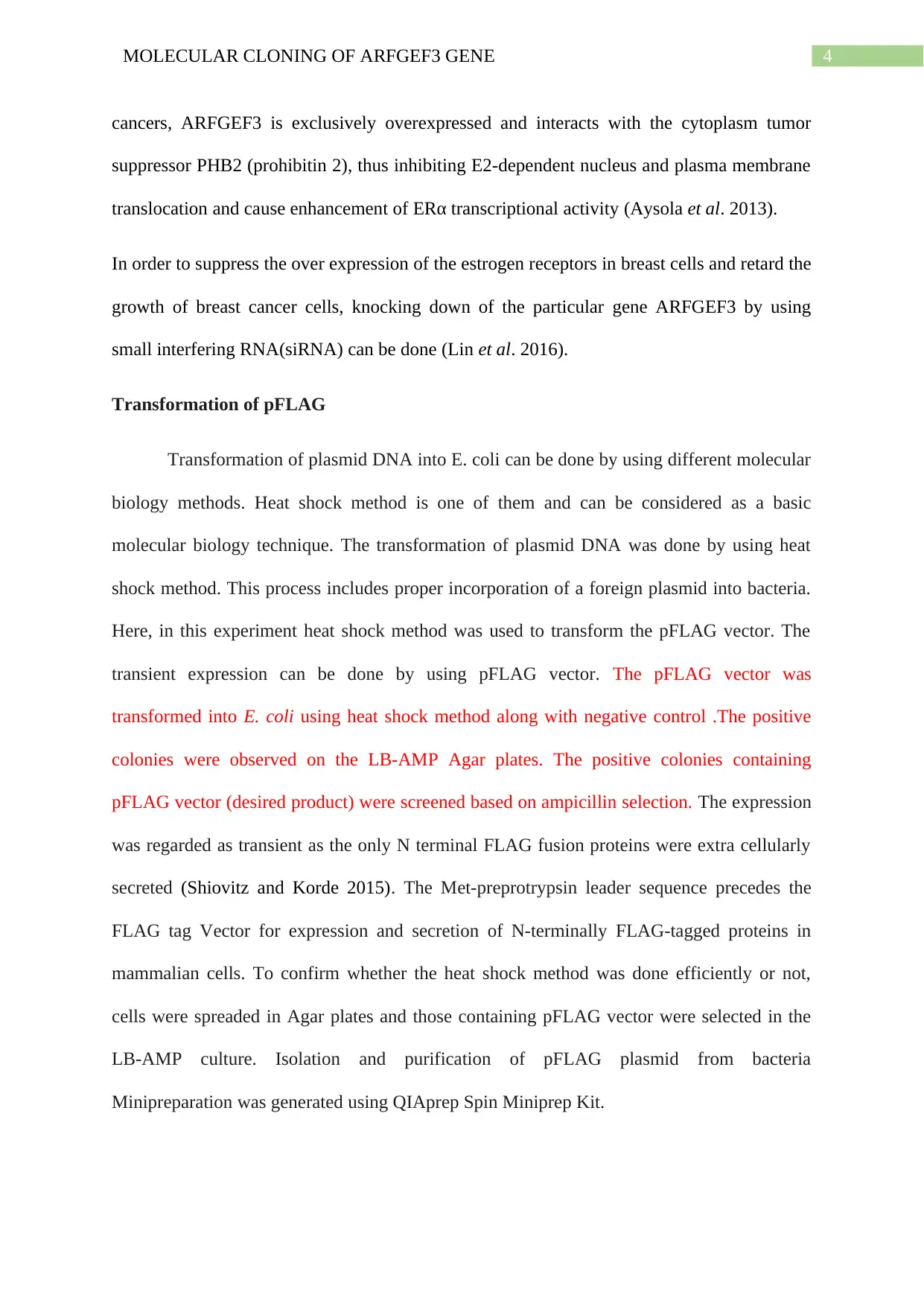
4MOLECULAR CLONING OF ARFGEF3 GENE
cancers, ARFGEF3 is exclusively overexpressed and interacts with the cytoplasm tumor
suppressor PHB2 (prohibitin 2), thus inhibiting E2-dependent nucleus and plasma membrane
translocation and cause enhancement of ERα transcriptional activity (Aysola et al. 2013).
In order to suppress the over expression of the estrogen receptors in breast cells and retard the
growth of breast cancer cells, knocking down of the particular gene ARFGEF3 by using
small interfering RNA(siRNA) can be done (Lin et al. 2016).
Transformation of pFLAG
Transformation of plasmid DNA into E. coli can be done by using different molecular
biology methods. Heat shock method is one of them and can be considered as a basic
molecular biology technique. The transformation of plasmid DNA was done by using heat
shock method. This process includes proper incorporation of a foreign plasmid into bacteria.
Here, in this experiment heat shock method was used to transform the pFLAG vector. The
transient expression can be done by using pFLAG vector. The pFLAG vector was
transformed into E. coli using heat shock method along with negative control .The positive
colonies were observed on the LB-AMP Agar plates. The positive colonies containing
pFLAG vector (desired product) were screened based on ampicillin selection. The expression
was regarded as transient as the only N terminal FLAG fusion proteins were extra cellularly
secreted (Shiovitz and Korde 2015). The Met-preprotrypsin leader sequence precedes the
FLAG tag Vector for expression and secretion of N-terminally FLAG-tagged proteins in
mammalian cells. To confirm whether the heat shock method was done efficiently or not,
cells were spreaded in Agar plates and those containing pFLAG vector were selected in the
LB-AMP culture. Isolation and purification of pFLAG plasmid from bacteria
Minipreparation was generated using QIAprep Spin Miniprep Kit.
cancers, ARFGEF3 is exclusively overexpressed and interacts with the cytoplasm tumor
suppressor PHB2 (prohibitin 2), thus inhibiting E2-dependent nucleus and plasma membrane
translocation and cause enhancement of ERα transcriptional activity (Aysola et al. 2013).
In order to suppress the over expression of the estrogen receptors in breast cells and retard the
growth of breast cancer cells, knocking down of the particular gene ARFGEF3 by using
small interfering RNA(siRNA) can be done (Lin et al. 2016).
Transformation of pFLAG
Transformation of plasmid DNA into E. coli can be done by using different molecular
biology methods. Heat shock method is one of them and can be considered as a basic
molecular biology technique. The transformation of plasmid DNA was done by using heat
shock method. This process includes proper incorporation of a foreign plasmid into bacteria.
Here, in this experiment heat shock method was used to transform the pFLAG vector. The
transient expression can be done by using pFLAG vector. The pFLAG vector was
transformed into E. coli using heat shock method along with negative control .The positive
colonies were observed on the LB-AMP Agar plates. The positive colonies containing
pFLAG vector (desired product) were screened based on ampicillin selection. The expression
was regarded as transient as the only N terminal FLAG fusion proteins were extra cellularly
secreted (Shiovitz and Korde 2015). The Met-preprotrypsin leader sequence precedes the
FLAG tag Vector for expression and secretion of N-terminally FLAG-tagged proteins in
mammalian cells. To confirm whether the heat shock method was done efficiently or not,
cells were spreaded in Agar plates and those containing pFLAG vector were selected in the
LB-AMP culture. Isolation and purification of pFLAG plasmid from bacteria
Minipreparation was generated using QIAprep Spin Miniprep Kit.
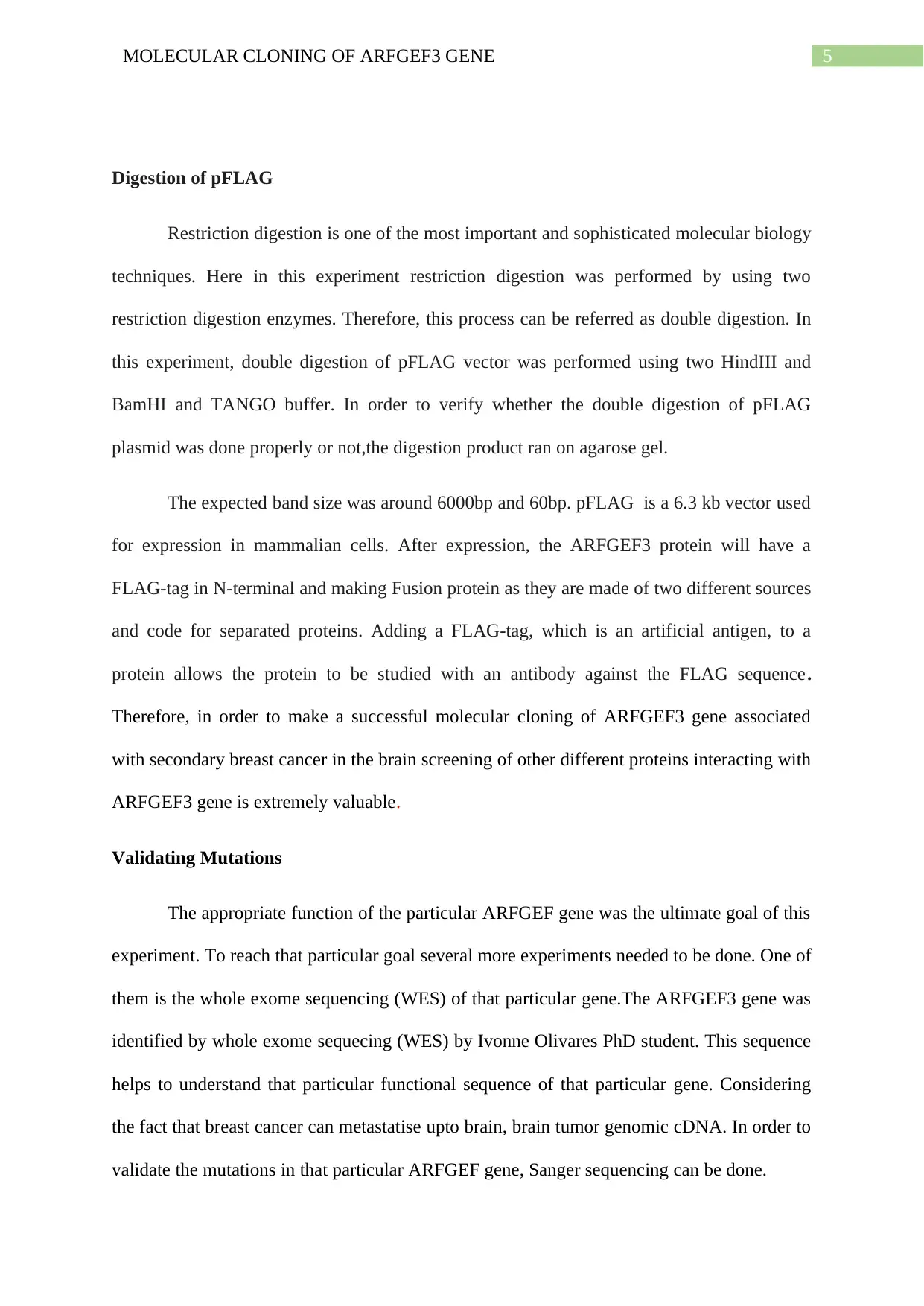
5MOLECULAR CLONING OF ARFGEF3 GENE
Digestion of pFLAG
Restriction digestion is one of the most important and sophisticated molecular biology
techniques. Here in this experiment restriction digestion was performed by using two
restriction digestion enzymes. Therefore, this process can be referred as double digestion. In
this experiment, double digestion of pFLAG vector was performed using two HindIII and
BamHI and TANGO buffer. In order to verify whether the double digestion of pFLAG
plasmid was done properly or not,the digestion product ran on agarose gel.
The expected band size was around 6000bp and 60bp. pFLAG is a 6.3 kb vector used
for expression in mammalian cells. After expression, the ARFGEF3 protein will have a
FLAG-tag in N-terminal and making Fusion protein as they are made of two different sources
and code for separated proteins. Adding a FLAG-tag, which is an artificial antigen, to a
protein allows the protein to be studied with an antibody against the FLAG sequence.
Therefore, in order to make a successful molecular cloning of ARFGEF3 gene associated
with secondary breast cancer in the brain screening of other different proteins interacting with
ARFGEF3 gene is extremely valuable.
Validating Mutations
The appropriate function of the particular ARFGEF gene was the ultimate goal of this
experiment. To reach that particular goal several more experiments needed to be done. One of
them is the whole exome sequencing (WES) of that particular gene.The ARFGEF3 gene was
identified by whole exome sequecing (WES) by Ivonne Olivares PhD student. This sequence
helps to understand that particular functional sequence of that particular gene. Considering
the fact that breast cancer can metastatise upto brain, brain tumor genomic cDNA. In order to
validate the mutations in that particular ARFGEF gene, Sanger sequencing can be done.
Digestion of pFLAG
Restriction digestion is one of the most important and sophisticated molecular biology
techniques. Here in this experiment restriction digestion was performed by using two
restriction digestion enzymes. Therefore, this process can be referred as double digestion. In
this experiment, double digestion of pFLAG vector was performed using two HindIII and
BamHI and TANGO buffer. In order to verify whether the double digestion of pFLAG
plasmid was done properly or not,the digestion product ran on agarose gel.
The expected band size was around 6000bp and 60bp. pFLAG is a 6.3 kb vector used
for expression in mammalian cells. After expression, the ARFGEF3 protein will have a
FLAG-tag in N-terminal and making Fusion protein as they are made of two different sources
and code for separated proteins. Adding a FLAG-tag, which is an artificial antigen, to a
protein allows the protein to be studied with an antibody against the FLAG sequence.
Therefore, in order to make a successful molecular cloning of ARFGEF3 gene associated
with secondary breast cancer in the brain screening of other different proteins interacting with
ARFGEF3 gene is extremely valuable.
Validating Mutations
The appropriate function of the particular ARFGEF gene was the ultimate goal of this
experiment. To reach that particular goal several more experiments needed to be done. One of
them is the whole exome sequencing (WES) of that particular gene.The ARFGEF3 gene was
identified by whole exome sequecing (WES) by Ivonne Olivares PhD student. This sequence
helps to understand that particular functional sequence of that particular gene. Considering
the fact that breast cancer can metastatise upto brain, brain tumor genomic cDNA. In order to
validate the mutations in that particular ARFGEF gene, Sanger sequencing can be done.
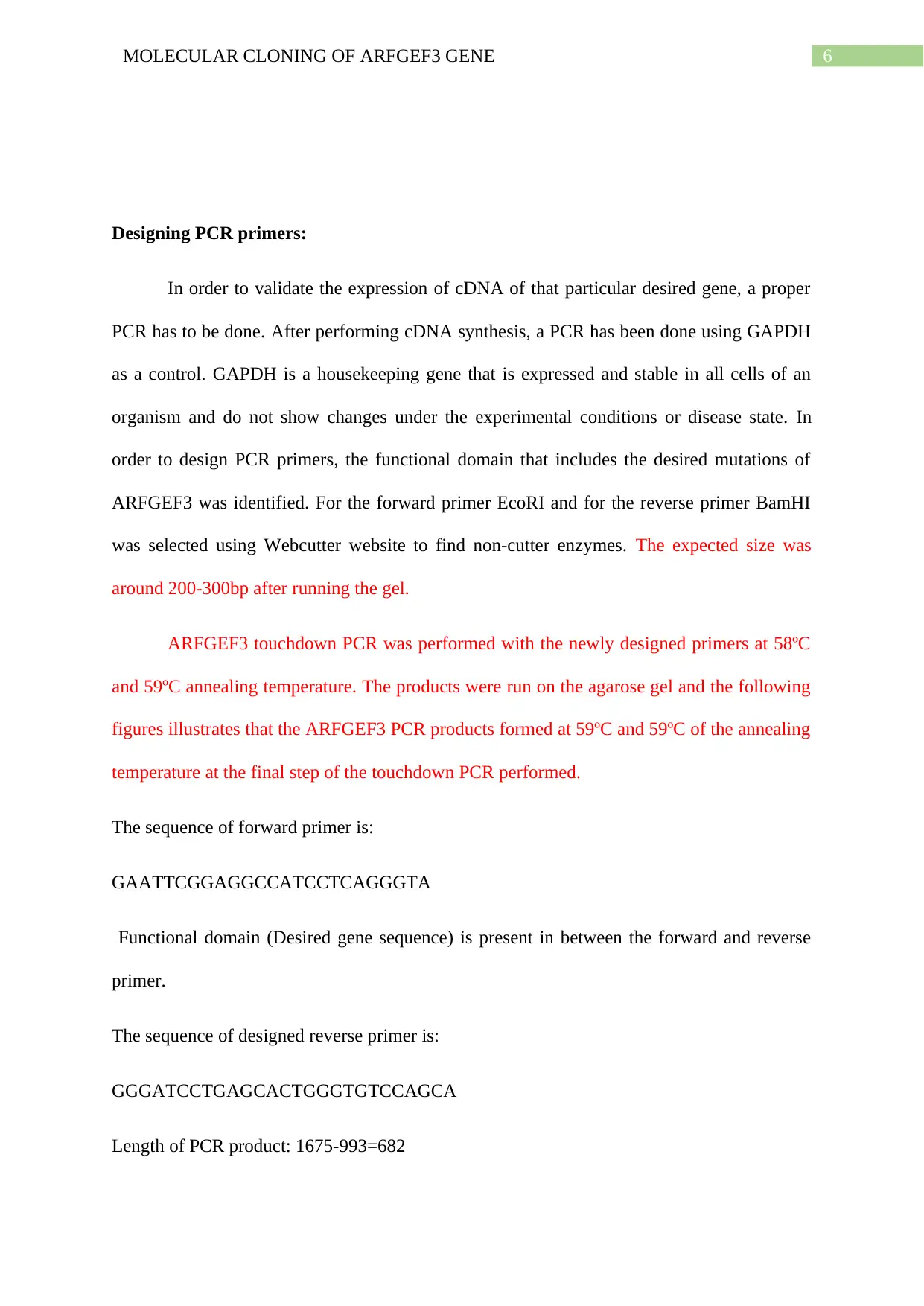
6MOLECULAR CLONING OF ARFGEF3 GENE
Designing PCR primers:
In order to validate the expression of cDNA of that particular desired gene, a proper
PCR has to be done. After performing cDNA synthesis, a PCR has been done using GAPDH
as a control. GAPDH is a housekeeping gene that is expressed and stable in all cells of an
organism and do not show changes under the experimental conditions or disease state. In
order to design PCR primers, the functional domain that includes the desired mutations of
ARFGEF3 was identified. For the forward primer EcoRI and for the reverse primer BamHI
was selected using Webcutter website to find non-cutter enzymes. The expected size was
around 200-300bp after running the gel.
ARFGEF3 touchdown PCR was performed with the newly designed primers at 58ºC
and 59ºC annealing temperature. The products were run on the agarose gel and the following
figures illustrates that the ARFGEF3 PCR products formed at 59ºC and 59ºC of the annealing
temperature at the final step of the touchdown PCR performed.
The sequence of forward primer is:
GAATTCGGAGGCCATCCTCAGGGTA
Functional domain (Desired gene sequence) is present in between the forward and reverse
primer.
The sequence of designed reverse primer is:
GGGATCCTGAGCACTGGGTGTCCAGCA
Length of PCR product: 1675-993=682
Designing PCR primers:
In order to validate the expression of cDNA of that particular desired gene, a proper
PCR has to be done. After performing cDNA synthesis, a PCR has been done using GAPDH
as a control. GAPDH is a housekeeping gene that is expressed and stable in all cells of an
organism and do not show changes under the experimental conditions or disease state. In
order to design PCR primers, the functional domain that includes the desired mutations of
ARFGEF3 was identified. For the forward primer EcoRI and for the reverse primer BamHI
was selected using Webcutter website to find non-cutter enzymes. The expected size was
around 200-300bp after running the gel.
ARFGEF3 touchdown PCR was performed with the newly designed primers at 58ºC
and 59ºC annealing temperature. The products were run on the agarose gel and the following
figures illustrates that the ARFGEF3 PCR products formed at 59ºC and 59ºC of the annealing
temperature at the final step of the touchdown PCR performed.
The sequence of forward primer is:
GAATTCGGAGGCCATCCTCAGGGTA
Functional domain (Desired gene sequence) is present in between the forward and reverse
primer.
The sequence of designed reverse primer is:
GGGATCCTGAGCACTGGGTGTCCAGCA
Length of PCR product: 1675-993=682
Paraphrase This Document
Need a fresh take? Get an instant paraphrase of this document with our AI Paraphraser
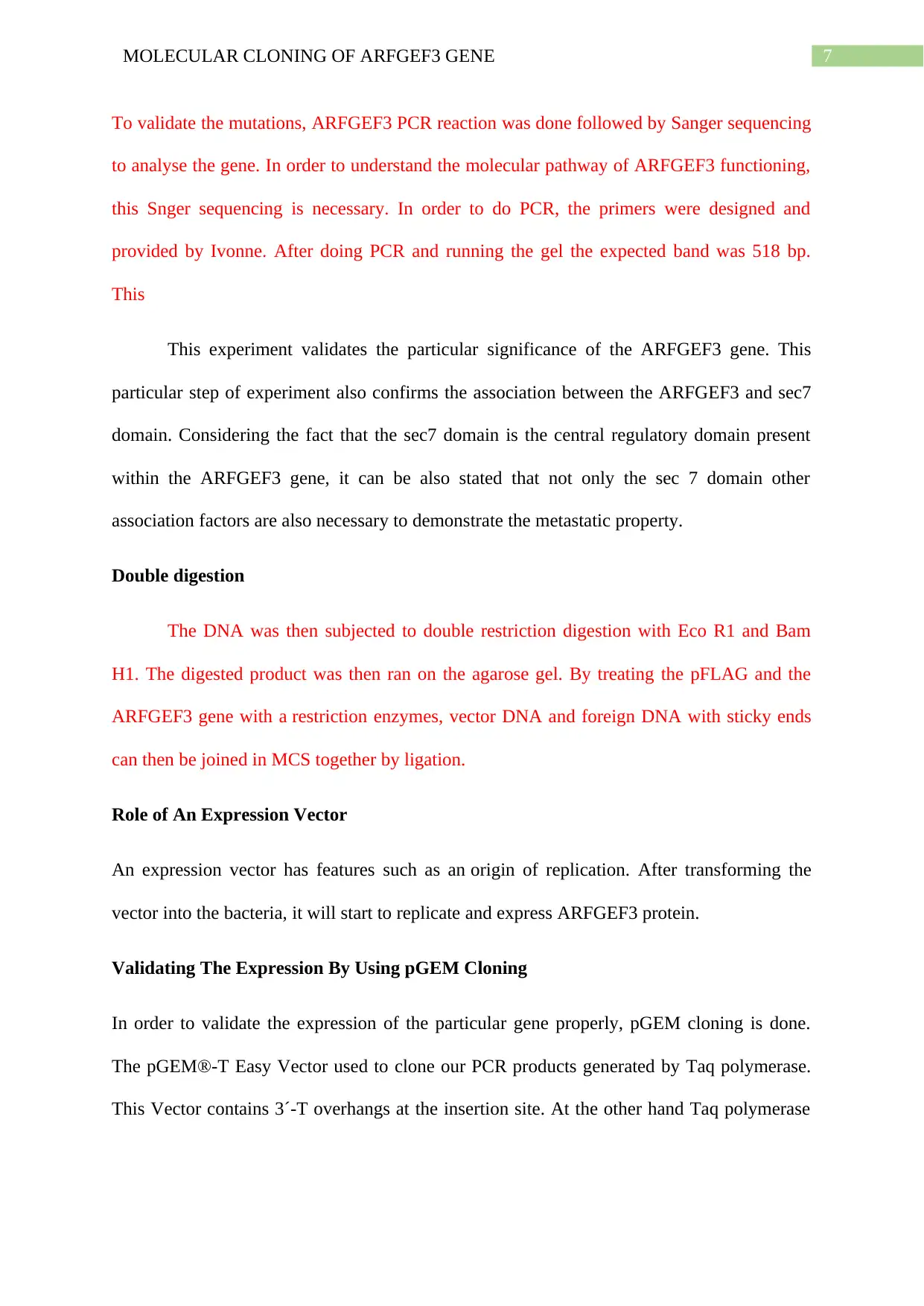
7MOLECULAR CLONING OF ARFGEF3 GENE
To validate the mutations, ARFGEF3 PCR reaction was done followed by Sanger sequencing
to analyse the gene. In order to understand the molecular pathway of ARFGEF3 functioning,
this Snger sequencing is necessary. In order to do PCR, the primers were designed and
provided by Ivonne. After doing PCR and running the gel the expected band was 518 bp.
This
This experiment validates the particular significance of the ARFGEF3 gene. This
particular step of experiment also confirms the association between the ARFGEF3 and sec7
domain. Considering the fact that the sec7 domain is the central regulatory domain present
within the ARFGEF3 gene, it can be also stated that not only the sec 7 domain other
association factors are also necessary to demonstrate the metastatic property.
Double digestion
The DNA was then subjected to double restriction digestion with Eco R1 and Bam
H1. The digested product was then ran on the agarose gel. By treating the pFLAG and the
ARFGEF3 gene with a restriction enzymes, vector DNA and foreign DNA with sticky ends
can then be joined in MCS together by ligation.
Role of An Expression Vector
An expression vector has features such as an origin of replication. After transforming the
vector into the bacteria, it will start to replicate and express ARFGEF3 protein.
Validating The Expression By Using pGEM Cloning
In order to validate the expression of the particular gene properly, pGEM cloning is done.
The pGEM®-T Easy Vector used to clone our PCR products generated by Taq polymerase.
This Vector contains 3´-T overhangs at the insertion site. At the other hand Taq polymerase
To validate the mutations, ARFGEF3 PCR reaction was done followed by Sanger sequencing
to analyse the gene. In order to understand the molecular pathway of ARFGEF3 functioning,
this Snger sequencing is necessary. In order to do PCR, the primers were designed and
provided by Ivonne. After doing PCR and running the gel the expected band was 518 bp.
This
This experiment validates the particular significance of the ARFGEF3 gene. This
particular step of experiment also confirms the association between the ARFGEF3 and sec7
domain. Considering the fact that the sec7 domain is the central regulatory domain present
within the ARFGEF3 gene, it can be also stated that not only the sec 7 domain other
association factors are also necessary to demonstrate the metastatic property.
Double digestion
The DNA was then subjected to double restriction digestion with Eco R1 and Bam
H1. The digested product was then ran on the agarose gel. By treating the pFLAG and the
ARFGEF3 gene with a restriction enzymes, vector DNA and foreign DNA with sticky ends
can then be joined in MCS together by ligation.
Role of An Expression Vector
An expression vector has features such as an origin of replication. After transforming the
vector into the bacteria, it will start to replicate and express ARFGEF3 protein.
Validating The Expression By Using pGEM Cloning
In order to validate the expression of the particular gene properly, pGEM cloning is done.
The pGEM®-T Easy Vector used to clone our PCR products generated by Taq polymerase.
This Vector contains 3´-T overhangs at the insertion site. At the other hand Taq polymerase

8MOLECULAR CLONING OF ARFGEF3 GENE
adds adenine to the end of the product and in the presence of ligase, they become ligated
together. Hence, no restriction enzymes are used in this experiment.
RT-PCR and gel extraction
The 386 bp required ARFGEF product was retrieved with the help of gel
extraction and ran again on the gel post gel exaction for verification of the size and quality.
RT-PCR was then carried out with gene specific expression primers. After pGEM
ligation, the vector which now has our PCR product will be transformed into bacteria. Then,
after AMP selection and miniprep, digested plasmid will be run on the gel Agarose.
Use of bioinformatics approach
After sequencing ARFGEF3 gene from pFLAG cloning, the sequence was subjected
to NCBI BLAST and similarity was found maximum with Homo sapiens chromosome 5
clone CTC-307A7 (GenBank: AC008426.4). Bioinformatics of the Homo sapiens
chromosome 5 clone CTC-307A7 (GenBank: AC008426.4) along with ARFGEF3 sequence
after pairwise alignment revealed 25.7% similarity between the two which is extremely
interesting. The sequencing needs to be repeated for validation of this similarity.
Advancement
After pGEM ligation, the vector which now has the desired PCR product will be
transformed into bacteria. Then, after AMP selection and miniprep, digested plasmid will be
run on the gel Agarose. After seeing the right bands, DNA will be extract and clean up from
gel. The last step is to sequence our PCR product to validate mutations and cloning it into
pFLAG vector.
Unsuccessful
adds adenine to the end of the product and in the presence of ligase, they become ligated
together. Hence, no restriction enzymes are used in this experiment.
RT-PCR and gel extraction
The 386 bp required ARFGEF product was retrieved with the help of gel
extraction and ran again on the gel post gel exaction for verification of the size and quality.
RT-PCR was then carried out with gene specific expression primers. After pGEM
ligation, the vector which now has our PCR product will be transformed into bacteria. Then,
after AMP selection and miniprep, digested plasmid will be run on the gel Agarose.
Use of bioinformatics approach
After sequencing ARFGEF3 gene from pFLAG cloning, the sequence was subjected
to NCBI BLAST and similarity was found maximum with Homo sapiens chromosome 5
clone CTC-307A7 (GenBank: AC008426.4). Bioinformatics of the Homo sapiens
chromosome 5 clone CTC-307A7 (GenBank: AC008426.4) along with ARFGEF3 sequence
after pairwise alignment revealed 25.7% similarity between the two which is extremely
interesting. The sequencing needs to be repeated for validation of this similarity.
Advancement
After pGEM ligation, the vector which now has the desired PCR product will be
transformed into bacteria. Then, after AMP selection and miniprep, digested plasmid will be
run on the gel Agarose. After seeing the right bands, DNA will be extract and clean up from
gel. The last step is to sequence our PCR product to validate mutations and cloning it into
pFLAG vector.
Unsuccessful
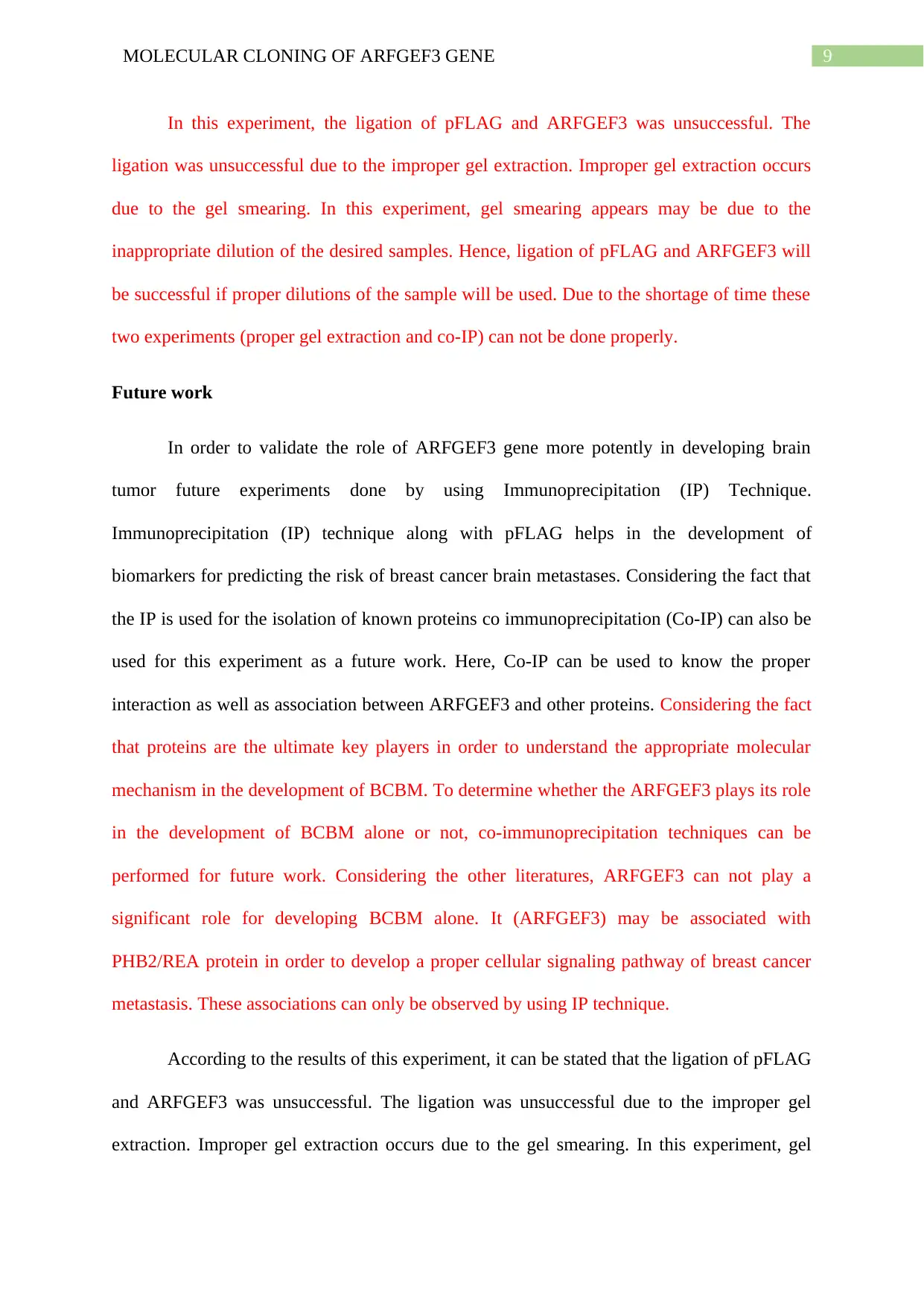
9MOLECULAR CLONING OF ARFGEF3 GENE
In this experiment, the ligation of pFLAG and ARFGEF3 was unsuccessful. The
ligation was unsuccessful due to the improper gel extraction. Improper gel extraction occurs
due to the gel smearing. In this experiment, gel smearing appears may be due to the
inappropriate dilution of the desired samples. Hence, ligation of pFLAG and ARFGEF3 will
be successful if proper dilutions of the sample will be used. Due to the shortage of time these
two experiments (proper gel extraction and co-IP) can not be done properly.
Future work
In order to validate the role of ARFGEF3 gene more potently in developing brain
tumor future experiments done by using Immunoprecipitation (IP) Technique.
Immunoprecipitation (IP) technique along with pFLAG helps in the development of
biomarkers for predicting the risk of breast cancer brain metastases. Considering the fact that
the IP is used for the isolation of known proteins co immunoprecipitation (Co-IP) can also be
used for this experiment as a future work. Here, Co-IP can be used to know the proper
interaction as well as association between ARFGEF3 and other proteins. Considering the fact
that proteins are the ultimate key players in order to understand the appropriate molecular
mechanism in the development of BCBM. To determine whether the ARFGEF3 plays its role
in the development of BCBM alone or not, co-immunoprecipitation techniques can be
performed for future work. Considering the other literatures, ARFGEF3 can not play a
significant role for developing BCBM alone. It (ARFGEF3) may be associated with
PHB2/REA protein in order to develop a proper cellular signaling pathway of breast cancer
metastasis. These associations can only be observed by using IP technique.
According to the results of this experiment, it can be stated that the ligation of pFLAG
and ARFGEF3 was unsuccessful. The ligation was unsuccessful due to the improper gel
extraction. Improper gel extraction occurs due to the gel smearing. In this experiment, gel
In this experiment, the ligation of pFLAG and ARFGEF3 was unsuccessful. The
ligation was unsuccessful due to the improper gel extraction. Improper gel extraction occurs
due to the gel smearing. In this experiment, gel smearing appears may be due to the
inappropriate dilution of the desired samples. Hence, ligation of pFLAG and ARFGEF3 will
be successful if proper dilutions of the sample will be used. Due to the shortage of time these
two experiments (proper gel extraction and co-IP) can not be done properly.
Future work
In order to validate the role of ARFGEF3 gene more potently in developing brain
tumor future experiments done by using Immunoprecipitation (IP) Technique.
Immunoprecipitation (IP) technique along with pFLAG helps in the development of
biomarkers for predicting the risk of breast cancer brain metastases. Considering the fact that
the IP is used for the isolation of known proteins co immunoprecipitation (Co-IP) can also be
used for this experiment as a future work. Here, Co-IP can be used to know the proper
interaction as well as association between ARFGEF3 and other proteins. Considering the fact
that proteins are the ultimate key players in order to understand the appropriate molecular
mechanism in the development of BCBM. To determine whether the ARFGEF3 plays its role
in the development of BCBM alone or not, co-immunoprecipitation techniques can be
performed for future work. Considering the other literatures, ARFGEF3 can not play a
significant role for developing BCBM alone. It (ARFGEF3) may be associated with
PHB2/REA protein in order to develop a proper cellular signaling pathway of breast cancer
metastasis. These associations can only be observed by using IP technique.
According to the results of this experiment, it can be stated that the ligation of pFLAG
and ARFGEF3 was unsuccessful. The ligation was unsuccessful due to the improper gel
extraction. Improper gel extraction occurs due to the gel smearing. In this experiment, gel
Secure Best Marks with AI Grader
Need help grading? Try our AI Grader for instant feedback on your assignments.

10MOLECULAR CLONING OF ARFGEF3 GENE
smearing appears may be due to the inappropriate dilution of the desired samples. Hence,
ligation of pFLAG and ARFGEF3 will be successful if proper dilutions of the sample will be
used. Due to the shortage of time these two experiments (proper gel extraction and co-IP) can
not be done properly. After performing the proper gel extraction method, co-IP can be done
in order to evaluate the association between the other proteins and ARFGEF3. Furthermore,
in order to validate the appropriate association between other genes and ARFGEF3 gene,
Sanger sequencing can be done. Sanger sequencing further identifies the exact regulatory
sequence involved in breast cancer brain metastasis (BCBM). This association further helps
to develop the proper signaling pathway of breast cancer metastasis upto brain. It can be
assumed that there are various other regulatory proteins, transcription factors and chaperones
along with ARFGEF3 protein that mediate the breast cancer brain metastasis.
smearing appears may be due to the inappropriate dilution of the desired samples. Hence,
ligation of pFLAG and ARFGEF3 will be successful if proper dilutions of the sample will be
used. Due to the shortage of time these two experiments (proper gel extraction and co-IP) can
not be done properly. After performing the proper gel extraction method, co-IP can be done
in order to evaluate the association between the other proteins and ARFGEF3. Furthermore,
in order to validate the appropriate association between other genes and ARFGEF3 gene,
Sanger sequencing can be done. Sanger sequencing further identifies the exact regulatory
sequence involved in breast cancer brain metastasis (BCBM). This association further helps
to develop the proper signaling pathway of breast cancer metastasis upto brain. It can be
assumed that there are various other regulatory proteins, transcription factors and chaperones
along with ARFGEF3 protein that mediate the breast cancer brain metastasis.
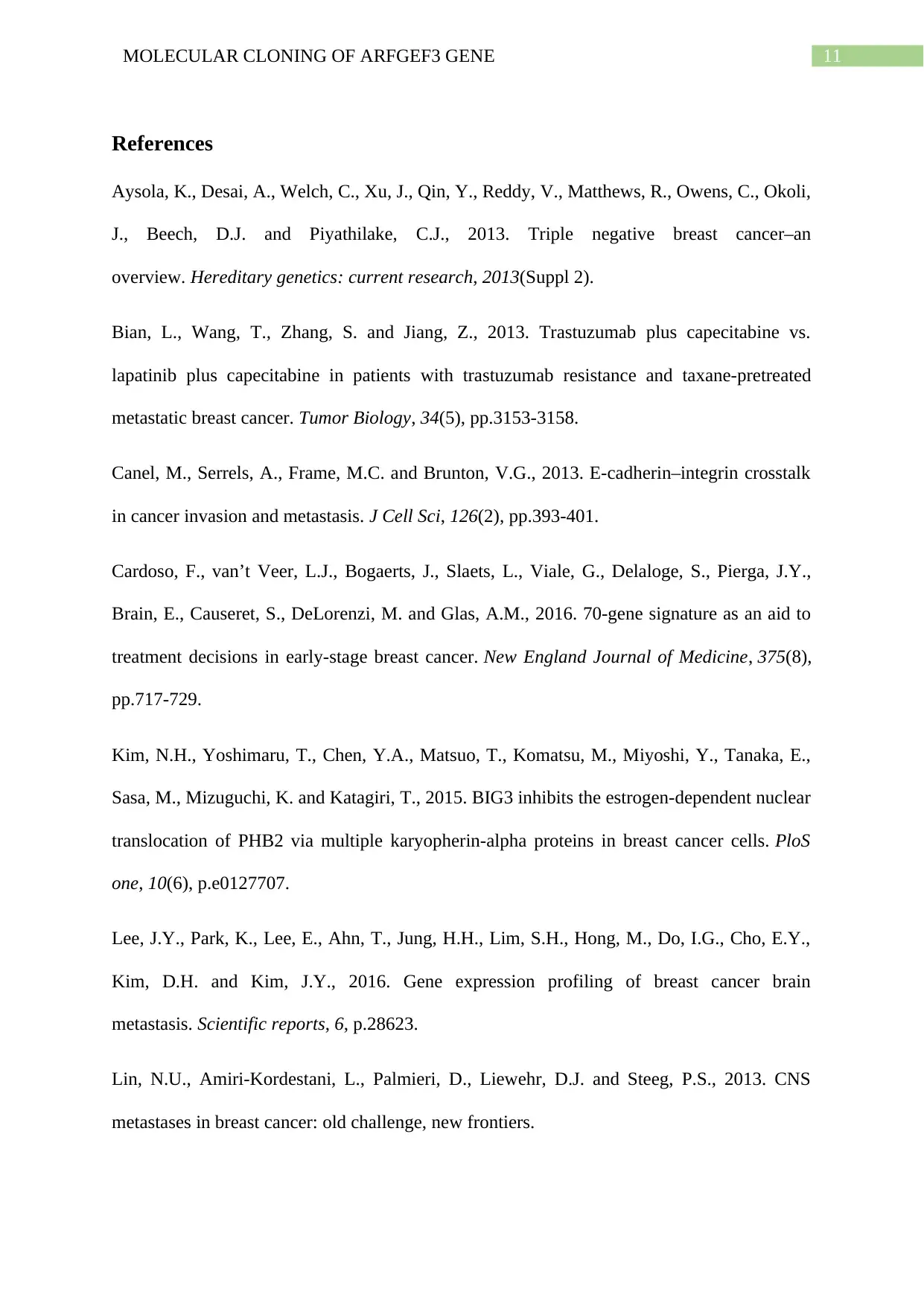
11MOLECULAR CLONING OF ARFGEF3 GENE
References
Aysola, K., Desai, A., Welch, C., Xu, J., Qin, Y., Reddy, V., Matthews, R., Owens, C., Okoli,
J., Beech, D.J. and Piyathilake, C.J., 2013. Triple negative breast cancer–an
overview. Hereditary genetics: current research, 2013(Suppl 2).
Bian, L., Wang, T., Zhang, S. and Jiang, Z., 2013. Trastuzumab plus capecitabine vs.
lapatinib plus capecitabine in patients with trastuzumab resistance and taxane-pretreated
metastatic breast cancer. Tumor Biology, 34(5), pp.3153-3158.
Canel, M., Serrels, A., Frame, M.C. and Brunton, V.G., 2013. E-cadherin–integrin crosstalk
in cancer invasion and metastasis. J Cell Sci, 126(2), pp.393-401.
Cardoso, F., van’t Veer, L.J., Bogaerts, J., Slaets, L., Viale, G., Delaloge, S., Pierga, J.Y.,
Brain, E., Causeret, S., DeLorenzi, M. and Glas, A.M., 2016. 70-gene signature as an aid to
treatment decisions in early-stage breast cancer. New England Journal of Medicine, 375(8),
pp.717-729.
Kim, N.H., Yoshimaru, T., Chen, Y.A., Matsuo, T., Komatsu, M., Miyoshi, Y., Tanaka, E.,
Sasa, M., Mizuguchi, K. and Katagiri, T., 2015. BIG3 inhibits the estrogen-dependent nuclear
translocation of PHB2 via multiple karyopherin-alpha proteins in breast cancer cells. PloS
one, 10(6), p.e0127707.
Lee, J.Y., Park, K., Lee, E., Ahn, T., Jung, H.H., Lim, S.H., Hong, M., Do, I.G., Cho, E.Y.,
Kim, D.H. and Kim, J.Y., 2016. Gene expression profiling of breast cancer brain
metastasis. Scientific reports, 6, p.28623.
Lin, N.U., Amiri-Kordestani, L., Palmieri, D., Liewehr, D.J. and Steeg, P.S., 2013. CNS
metastases in breast cancer: old challenge, new frontiers.
References
Aysola, K., Desai, A., Welch, C., Xu, J., Qin, Y., Reddy, V., Matthews, R., Owens, C., Okoli,
J., Beech, D.J. and Piyathilake, C.J., 2013. Triple negative breast cancer–an
overview. Hereditary genetics: current research, 2013(Suppl 2).
Bian, L., Wang, T., Zhang, S. and Jiang, Z., 2013. Trastuzumab plus capecitabine vs.
lapatinib plus capecitabine in patients with trastuzumab resistance and taxane-pretreated
metastatic breast cancer. Tumor Biology, 34(5), pp.3153-3158.
Canel, M., Serrels, A., Frame, M.C. and Brunton, V.G., 2013. E-cadherin–integrin crosstalk
in cancer invasion and metastasis. J Cell Sci, 126(2), pp.393-401.
Cardoso, F., van’t Veer, L.J., Bogaerts, J., Slaets, L., Viale, G., Delaloge, S., Pierga, J.Y.,
Brain, E., Causeret, S., DeLorenzi, M. and Glas, A.M., 2016. 70-gene signature as an aid to
treatment decisions in early-stage breast cancer. New England Journal of Medicine, 375(8),
pp.717-729.
Kim, N.H., Yoshimaru, T., Chen, Y.A., Matsuo, T., Komatsu, M., Miyoshi, Y., Tanaka, E.,
Sasa, M., Mizuguchi, K. and Katagiri, T., 2015. BIG3 inhibits the estrogen-dependent nuclear
translocation of PHB2 via multiple karyopherin-alpha proteins in breast cancer cells. PloS
one, 10(6), p.e0127707.
Lee, J.Y., Park, K., Lee, E., Ahn, T., Jung, H.H., Lim, S.H., Hong, M., Do, I.G., Cho, E.Y.,
Kim, D.H. and Kim, J.Y., 2016. Gene expression profiling of breast cancer brain
metastasis. Scientific reports, 6, p.28623.
Lin, N.U., Amiri-Kordestani, L., Palmieri, D., Liewehr, D.J. and Steeg, P.S., 2013. CNS
metastases in breast cancer: old challenge, new frontiers.
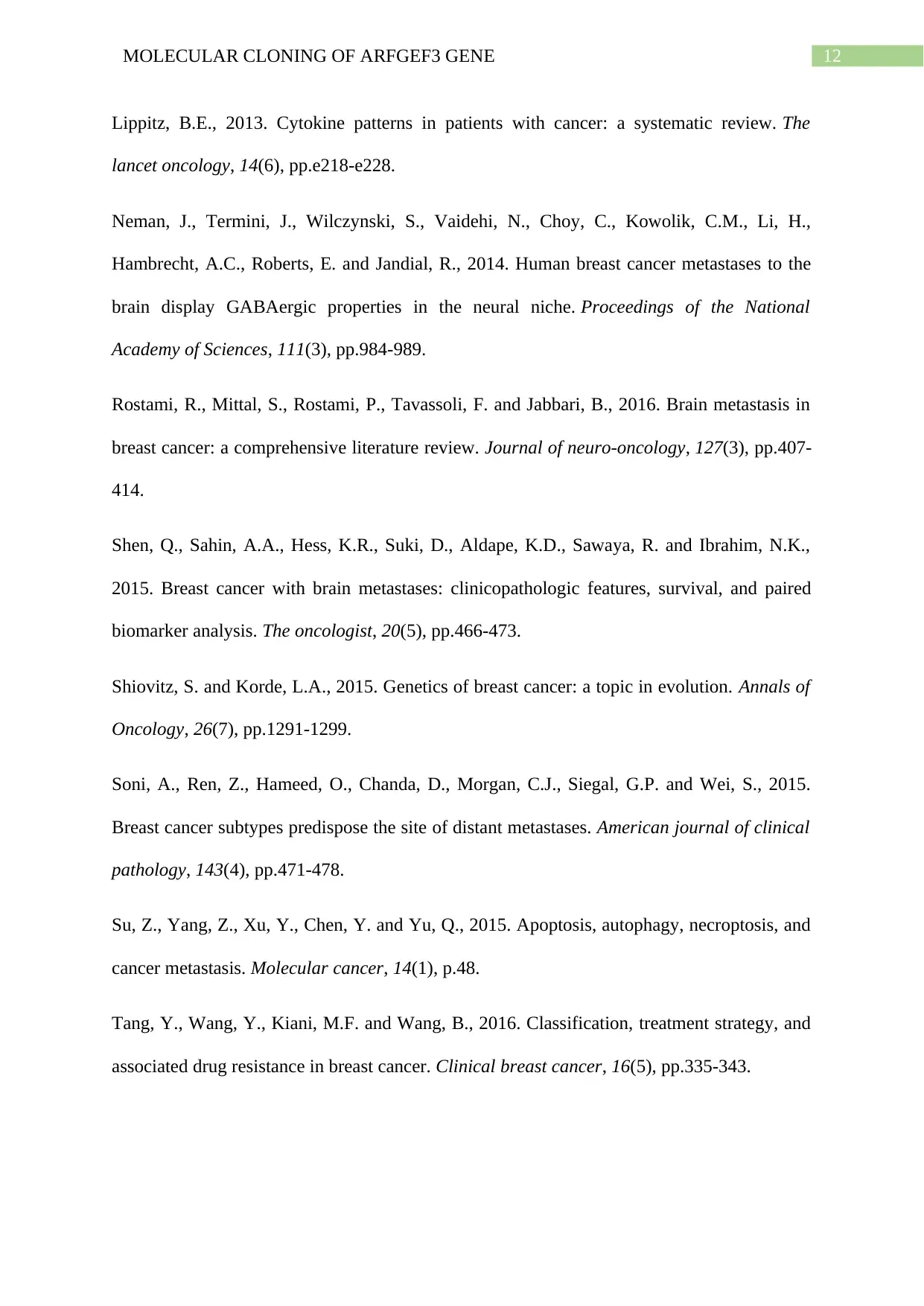
12MOLECULAR CLONING OF ARFGEF3 GENE
Lippitz, B.E., 2013. Cytokine patterns in patients with cancer: a systematic review. The
lancet oncology, 14(6), pp.e218-e228.
Neman, J., Termini, J., Wilczynski, S., Vaidehi, N., Choy, C., Kowolik, C.M., Li, H.,
Hambrecht, A.C., Roberts, E. and Jandial, R., 2014. Human breast cancer metastases to the
brain display GABAergic properties in the neural niche. Proceedings of the National
Academy of Sciences, 111(3), pp.984-989.
Rostami, R., Mittal, S., Rostami, P., Tavassoli, F. and Jabbari, B., 2016. Brain metastasis in
breast cancer: a comprehensive literature review. Journal of neuro-oncology, 127(3), pp.407-
414.
Shen, Q., Sahin, A.A., Hess, K.R., Suki, D., Aldape, K.D., Sawaya, R. and Ibrahim, N.K.,
2015. Breast cancer with brain metastases: clinicopathologic features, survival, and paired
biomarker analysis. The oncologist, 20(5), pp.466-473.
Shiovitz, S. and Korde, L.A., 2015. Genetics of breast cancer: a topic in evolution. Annals of
Oncology, 26(7), pp.1291-1299.
Soni, A., Ren, Z., Hameed, O., Chanda, D., Morgan, C.J., Siegal, G.P. and Wei, S., 2015.
Breast cancer subtypes predispose the site of distant metastases. American journal of clinical
pathology, 143(4), pp.471-478.
Su, Z., Yang, Z., Xu, Y., Chen, Y. and Yu, Q., 2015. Apoptosis, autophagy, necroptosis, and
cancer metastasis. Molecular cancer, 14(1), p.48.
Tang, Y., Wang, Y., Kiani, M.F. and Wang, B., 2016. Classification, treatment strategy, and
associated drug resistance in breast cancer. Clinical breast cancer, 16(5), pp.335-343.
Lippitz, B.E., 2013. Cytokine patterns in patients with cancer: a systematic review. The
lancet oncology, 14(6), pp.e218-e228.
Neman, J., Termini, J., Wilczynski, S., Vaidehi, N., Choy, C., Kowolik, C.M., Li, H.,
Hambrecht, A.C., Roberts, E. and Jandial, R., 2014. Human breast cancer metastases to the
brain display GABAergic properties in the neural niche. Proceedings of the National
Academy of Sciences, 111(3), pp.984-989.
Rostami, R., Mittal, S., Rostami, P., Tavassoli, F. and Jabbari, B., 2016. Brain metastasis in
breast cancer: a comprehensive literature review. Journal of neuro-oncology, 127(3), pp.407-
414.
Shen, Q., Sahin, A.A., Hess, K.R., Suki, D., Aldape, K.D., Sawaya, R. and Ibrahim, N.K.,
2015. Breast cancer with brain metastases: clinicopathologic features, survival, and paired
biomarker analysis. The oncologist, 20(5), pp.466-473.
Shiovitz, S. and Korde, L.A., 2015. Genetics of breast cancer: a topic in evolution. Annals of
Oncology, 26(7), pp.1291-1299.
Soni, A., Ren, Z., Hameed, O., Chanda, D., Morgan, C.J., Siegal, G.P. and Wei, S., 2015.
Breast cancer subtypes predispose the site of distant metastases. American journal of clinical
pathology, 143(4), pp.471-478.
Su, Z., Yang, Z., Xu, Y., Chen, Y. and Yu, Q., 2015. Apoptosis, autophagy, necroptosis, and
cancer metastasis. Molecular cancer, 14(1), p.48.
Tang, Y., Wang, Y., Kiani, M.F. and Wang, B., 2016. Classification, treatment strategy, and
associated drug resistance in breast cancer. Clinical breast cancer, 16(5), pp.335-343.
Paraphrase This Document
Need a fresh take? Get an instant paraphrase of this document with our AI Paraphraser
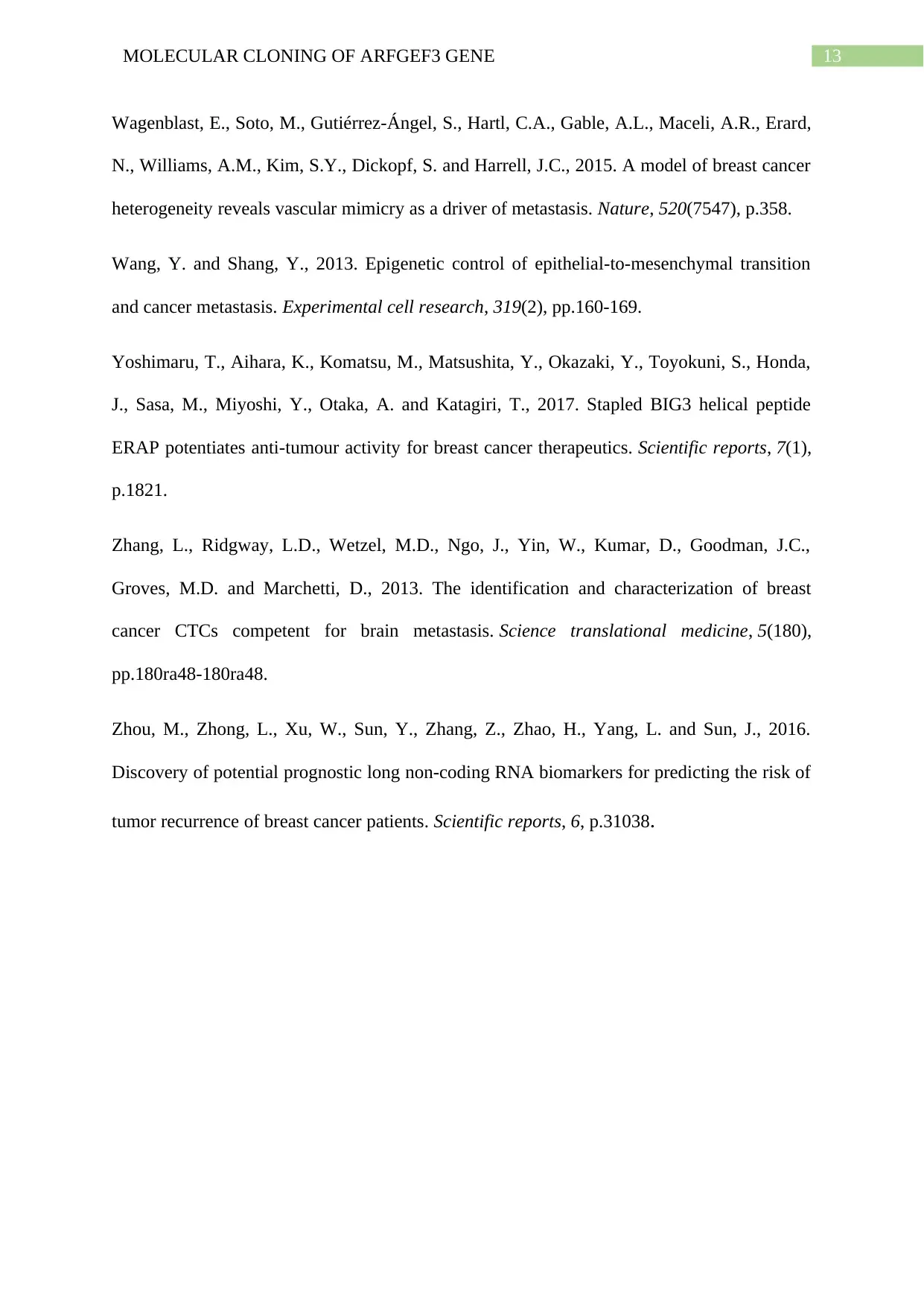
13MOLECULAR CLONING OF ARFGEF3 GENE
Wagenblast, E., Soto, M., Gutiérrez-Ángel, S., Hartl, C.A., Gable, A.L., Maceli, A.R., Erard,
N., Williams, A.M., Kim, S.Y., Dickopf, S. and Harrell, J.C., 2015. A model of breast cancer
heterogeneity reveals vascular mimicry as a driver of metastasis. Nature, 520(7547), p.358.
Wang, Y. and Shang, Y., 2013. Epigenetic control of epithelial-to-mesenchymal transition
and cancer metastasis. Experimental cell research, 319(2), pp.160-169.
Yoshimaru, T., Aihara, K., Komatsu, M., Matsushita, Y., Okazaki, Y., Toyokuni, S., Honda,
J., Sasa, M., Miyoshi, Y., Otaka, A. and Katagiri, T., 2017. Stapled BIG3 helical peptide
ERAP potentiates anti-tumour activity for breast cancer therapeutics. Scientific reports, 7(1),
p.1821.
Zhang, L., Ridgway, L.D., Wetzel, M.D., Ngo, J., Yin, W., Kumar, D., Goodman, J.C.,
Groves, M.D. and Marchetti, D., 2013. The identification and characterization of breast
cancer CTCs competent for brain metastasis. Science translational medicine, 5(180),
pp.180ra48-180ra48.
Zhou, M., Zhong, L., Xu, W., Sun, Y., Zhang, Z., Zhao, H., Yang, L. and Sun, J., 2016.
Discovery of potential prognostic long non-coding RNA biomarkers for predicting the risk of
tumor recurrence of breast cancer patients. Scientific reports, 6, p.31038.
Wagenblast, E., Soto, M., Gutiérrez-Ángel, S., Hartl, C.A., Gable, A.L., Maceli, A.R., Erard,
N., Williams, A.M., Kim, S.Y., Dickopf, S. and Harrell, J.C., 2015. A model of breast cancer
heterogeneity reveals vascular mimicry as a driver of metastasis. Nature, 520(7547), p.358.
Wang, Y. and Shang, Y., 2013. Epigenetic control of epithelial-to-mesenchymal transition
and cancer metastasis. Experimental cell research, 319(2), pp.160-169.
Yoshimaru, T., Aihara, K., Komatsu, M., Matsushita, Y., Okazaki, Y., Toyokuni, S., Honda,
J., Sasa, M., Miyoshi, Y., Otaka, A. and Katagiri, T., 2017. Stapled BIG3 helical peptide
ERAP potentiates anti-tumour activity for breast cancer therapeutics. Scientific reports, 7(1),
p.1821.
Zhang, L., Ridgway, L.D., Wetzel, M.D., Ngo, J., Yin, W., Kumar, D., Goodman, J.C.,
Groves, M.D. and Marchetti, D., 2013. The identification and characterization of breast
cancer CTCs competent for brain metastasis. Science translational medicine, 5(180),
pp.180ra48-180ra48.
Zhou, M., Zhong, L., Xu, W., Sun, Y., Zhang, Z., Zhao, H., Yang, L. and Sun, J., 2016.
Discovery of potential prognostic long non-coding RNA biomarkers for predicting the risk of
tumor recurrence of breast cancer patients. Scientific reports, 6, p.31038.
1 out of 14
Your All-in-One AI-Powered Toolkit for Academic Success.
+13062052269
info@desklib.com
Available 24*7 on WhatsApp / Email
![[object Object]](/_next/static/media/star-bottom.7253800d.svg)
Unlock your academic potential
© 2024 | Zucol Services PVT LTD | All rights reserved.